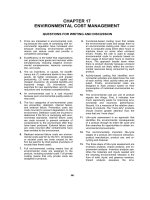Solution manual managerial accounting and finance for hospitality OperationsCHAPTER 17
Bạn đang xem bản rút gọn của tài liệu. Xem và tải ngay bản đầy đủ của tài liệu tại đây (45.22 KB, 3 trang )
CHAPTER 17
INTERMEDIATE FINANCING
I.
Questions
1.
A term loan is a business loan with a maturity of more than one year. These
loans are privately negotiable between the borrower and the lender.
2.
The lender incorporates covenants or provisions into the term loan agreement as
safeguards against default on the loan. These covenants restrict the scope of the
borrower’s activities.
3.
The major advantages of term loans include speed, flexibility, low issuance
costs, and the avoidance of possible nonrenewal of short-term loans.
The disadvantages of term loans include restrictive loan provisions, the use of
collateral in some cases, higher costs than short-term loans, and the cash drain
from making annuity payments.
4.
A lease is an agreement in which the owner or lessor of an asset agrees to let
another party or lessee use the asset in return for specified payments.
5.
The basic types of leases are operating and financial. Operating leases are
cancelable, include maintenance and service in the lease payment, have a
contract life shorter than the economic life of the asset, and do not fully amortize
the cost of the asset.
II. True or False
1.
2.
3.
4.
5.
True
False
True
False
True
III. Practical Problems
PROBLEM 1
6.
7.
8.
9.
True
False
False
True
17-2
Solutions Manual - Managerial Accounting and Finance for Hospitality Operations
(a) The annual loan payment, A, of P180,668 is found by substituting the amount of
the loan, P1,000,000, and PVIFA 0.09, 8 = 5.535 (Appendix B) in the equation
shown on the next page.
A
Amount of the loan
PVIFA 0.09, 8
=
P1,000,000
5.535
=
P180,668
=
(b) The total interest paid on the loan is approximately P445,344.
Total payments (8 x P180,668)................................. P1,445,344
Amount of the loan (principal)................................... 1,000,000
Total interest.............................................................. P 445,344
PROBLEM 2
Solving this problem requires rewriting the equation for annual loan payment in
problem 1 in order to determine the amount of the loan and substituting the yearly
loan payment, A = P20,000, and PVIFA 0.14, 4 = 2.914 (Appendix B), in the new
equation as follows:
Amount of the loan
=
(A) (PVIFA 0.14, 4)
=
(P20,000) (2.914) = P58,280
PROBLEM 3
1.
The annual loan payment, P78,864.35, is calculated by substituting the amount
of the loan, P250,000, and PVIFA 0.10, 4 = 3.170 (Appendix B) in the equation
below.
A
2.
Amount of the loan
PVIFA 0.10, 4
=
P250,000
3.170
=
P78,864.35
=
End of
Year
(1)
Beginning
Balance
(2)
Loan
Payment
(3)
Interest
Payment
[0.10 x (2)]
(4)
1
2
3
4
P250,000
196,136
136,886
71,711
P78,864
78,864
78,864
78,864
P25,000
19,614
13,689
7,171
Principal
Reduction
[(3) –
(4)]
(5)
P53,864
59,250
65,175
71,693
Remaining
Balance
[(2) – (5)]
(6)
P196,136
136,886
71,711
0*
* The actual remaining balance in Year 4 is P18 (P71,711 – P71,693), which
is due to rounding errors. Without rounding errors, the remaining balance
would be exactly zero.
Interest is based on the declining balance of the loan. Since the payments
remain constant, the reduction in principal would be exactly zero.









